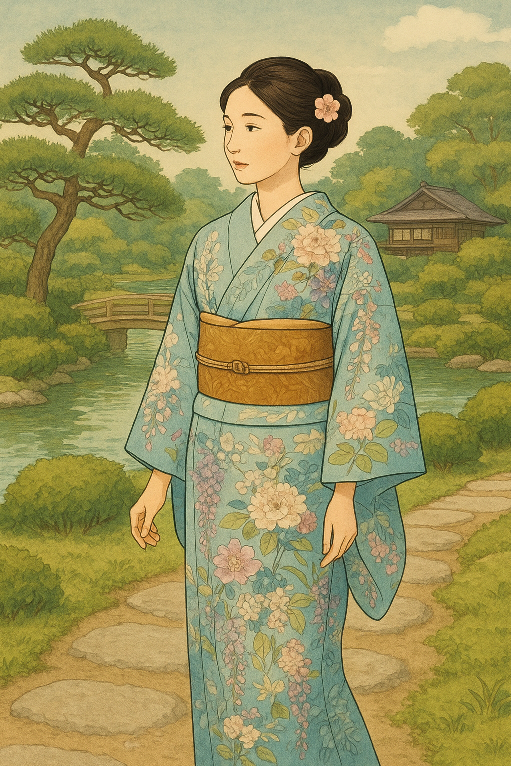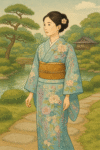
Among the many forms of Japanese kimono, Kaga Yuzen holds a special place as a symbol of elegance and artistry. Originating in Kanazawa, Ishikawa Prefecture, this textile dyeing technique dates back to the 17th century and has been admired for centuries as one of Japan’s most refined cultural traditions.
What sets Kaga Yuzen apart is its exquisite use of naturalistic designs. Unlike other kimono dyeing styles that emphasize bold patterns, Kaga Yuzen favors delicate, lifelike depictions of flowers, birds, and seasonal scenery. The colors are subtle yet striking, often using gradations known as bokashi, which create a sense of depth and softness. Each piece is hand-dyed with remarkable precision, making every kimono a unique work of art.
The roots of Kaga Yuzen trace back to Miyazaki Yuzensai, a Kyoto artist whose style of painting influenced the development of this technique. When it flourished in Kanazawa, it embraced the region’s appreciation for nature and harmony, becoming a treasured cultural asset of the area. Over time, Kaga Yuzen kimono became popular not only among samurai families but also among townspeople, symbolizing sophistication and refined taste.
Today, while the demand for traditional kimono has declined in daily life, Kaga Yuzen continues to evolve. Artisans are now applying the technique to modern fashion, interior design, and even accessories, keeping the tradition alive while appealing to new generations. Workshops in Kanazawa also allow visitors to try hand-dyeing themselves, offering a unique cultural experience for travelers.
For anyone interested in Japanese culture, Kaga Yuzen is more than just a kimono—it is a living art form that connects past and present, tradition and innovation. A visit to Kanazawa is not complete without discovering the timeless beauty of this celebrated craft.
加賀友禅:金沢の着物芸術の洗練された優雅さ
数多くの日本の着物の形の中で、加賀友禅は優雅さと芸術性の象徴として特別な位置を占めています。石川県金沢に起源を持つこの染色技法は17世紀にさかのぼり、何世紀にもわたって日本でもっとも洗練された文化的伝統の一つとして称賛されてきました。
加賀友禅を際立たせているのは、自然主義的なデザインの見事な使用です。大胆な模様を強調する他の着物染色スタイルとは異なり、加賀友禅は花や鳥、季節の風景を繊細で生き生きとした描写を好みます。色彩は控えめでありながら印象的で、しばしば「ぼかし」と呼ばれるグラデーションを用いて、奥行きと柔らかさを生み出します。それぞれの作品は驚くべき精密さで手染めされており、すべての着物は唯一無二の芸術作品となります。
加賀友禅の起源は、画風がこの技法の発展に影響を与えた京都の絵師・宮崎友禅斎にさかのぼります。金沢で花開いたとき、それは地域の自然や調和への敬愛を取り込み、この土地の貴重な文化的財産となりました。時を経て、加賀友禅の着物は武士の家族の間だけでなく町人の間でも人気となり、洗練と優雅な趣味の象徴となりました。
今日では、日常生活での伝統的な着物の需要は減少しているものの、加賀友禅は進化を続けています。職人たちはこの技法を現代ファッション、インテリアデザイン、さらには小物にまで応用し、新しい世代に訴えかけながら伝統を生かし続けています。金沢では旅行者が自ら手染めを体験できる工房もあり、ユニークな文化体験を提供しています。
日本文化に関心のある人にとって、加賀友禅は単なる着物以上のものです―それは過去と現在、伝統と革新を結びつける生きた芸術なのです。金沢を訪れるなら、この名高い工芸の時を超えた美しさを発見せずに帰ることはできません。
